
by Jessica Hughes | May 20, 2022 | General Featured
by Jessica Hughes

Rendering of the revamped 16th Street Mall. Rendering provided by Denver Department of Transportation and Infrastructure

Breaking ground on the new 16th Street Mall Project. From left: Laura Aldrete, executive director of Community Planning and Development, Kourtny Garrett, CEO of the Downtown Denver Partnership, Mayor Michael B. Hancock, Fred Worthen the Assistant General Manager for Bus Operations of RTD, Adam Phipps, the Executive Director of the Department of Transportation & Infrastructure, and Councilmember Chris Hinds. Photo provided by City and County of Denver
After 40 long years, Denver’s 16th Street Mall is finally getting some love in the form of a much-needed makeover. On April 14, 2022, Mayor Michael B. Hancock gathered with downtown Denver residents and businesses for the groundbreaking ceremony on the 16th Street Mall Project. The long-awaited project serves to breathe new life into the iconic pedestrian destination.
As many Denverites know all too well, for years, downtown has been a contentious topic of conversation with its increased crime rate, rampant drug use, and the city’s continued efforts to support those who are unhoused. So, it should come as no surprise that the city finally put the plans in place for this necessary revitalization.
After years of discussions around downtown renovations, in 2019 the city received approval to move forward with the project. Funding for the $149 million project came from a mix of local, state, and federal funds, including voter approved Elevate Denver bond funds and contributions from partners including the Denver Urban Renewal Authority, Colorado Department of Transportation, and Federal Transit Administration.
“This is a truly monumental day in the life of our downtown as we kick off a project that will secure the future of the 16th Street Mall for generations to come,” Mayor Hancock said. “The 16th Street Mall reconstruction is a key part of downtown’s comeback and will set the pace of Denver’s overall equitable and sustainable economic recovery.”
The 16th Street Mall Project is the first major renovation of this vital downtown corridor since its opening in 1982. A primary driver for the project is the need to address deteriorating infrastructure, specifically the granite paver system, that results in poor drainage, frequent disruptions to the transit system, and maintenance costs of more than $1M annually.
“The 16th Street Mall is one of the city’s most important public spaces, serving millions of people each year,” said Kourtny Garrett, President and CEO of the Downtown Denver Partnership. “This project will enhance the overall experience for residents, employees, and visitors, ensuring the Mall remains Denver’s Main Street. For now, it’s more important than ever that we rally behind the businesses that make Downtown special and ensure they have the resources they need to thrive during construction.”
To support the small businesses along the mall during construction, the City and County of Denver will issue $1M from the city’s 2022 General Fund. Plus, the city is partnering with the Downtown Denver Partnership to distribute grants and technical assistance to eligible small businesses along the mall.
The city selected PCL Construction Services as the design/build firm to carry out the 16th Street Mall Project. Visitors will begin to see improvements to infrastructure taking place along 13 blocks of the main corridor from Market Street to Broadway. Work will begin between Market and Larimer Streets, with the project wrapping up at the end of 2024.

Construction equipment with colorful balloons that will be a hallmark of the project. Photo provided by City and County of Denver
Some of the biggest changes visitors are likely to notice the most will be the wider pedestrian walkways, new designated areas for entertainment, and exciting new art that will draw visitors to the corridor. Additionally, the project will replace the Mall’s existing granite paver system with one that drains more effectively and offers greater surface friction to improve overall safety and expanding the Mall’s tree canopy for improved beautification.
The 16th Street Mall renovation is a component of Denver’s overall financial plan for an equitable and sustainable economic recovery and is anticipated to support more than 1,800 jobs, generate more than $155 million in income for workers, nearly $380 million in sales for businesses, and have a regional economic impact of as much as $4 billion throughout the duration of the project.
The RTD Free MallRide shuttle will continue to run during the 16th Street Mall project, rerouted to 15th and 17th Streets as needed. RTD will update the public on their MallRide page.
Access to all businesses will be maintained throughout the project. More information and updates about the project are available at www.denvergov.org/16th StreetMall. People can also stay connected to the project by searching “16th Street Mall Project” in the Apple or Google Play stores and downloading the mobile app.

by Regan Bervar | May 20, 2022 | Travel
High Ridin’ Todd Bannister
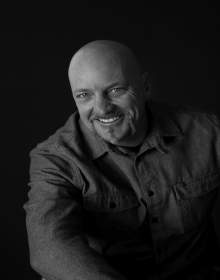 by Luke Schmaltz
by Luke Schmaltz
Todd Bannister is a competitive dirt bike rider, participating in the Monster Energy AMA (American Motocross Assn.) Supercross Championship.
For the uninitiated, this extreme iteration of motocross features pyrotechnics, huge jumps, and hairpin turns on a track of dirt and mud that looks like it is designed to punish as much as it is to entertain.
Meanwhile, stadiums full of exuberant fans cheer on their favorite riders and savor the carnage when the inevitable body-mangling pileups take place.
Road Worthy
Although he was born in Colorado Springs, Bannister currently resides in Eaton, Colo. That is, when he isn’t out on the road pushing his personal boundaries to further his position in the overall rankings.
Bannister competes as a “privateer” which means he is not a corporate-sponsored, factory-backed rider with a huge team of technicians, an enormous budget, and the high-profile hoopla that comes with all of the hype.
To the contrary, Bannister exudes positivity, humility, and a genuine smile that no doubt makes his handful of sponsors, his family and his fellow member of Team Faith proud to be in his corner.

Doggone Exciting: Colorado hero, shown with his riding companion, competes in the Supercross circuit with a winning smile.
Vision And Purpose
Team Faith was founded in 1994 by Brian O’Rourke, a former high-level competitor in the sport who now serves as Manager and Team President.
O’Rourke’s vision is to imbue the tremendous impact extreme sports stars have on young people with a positive, constructive message.
After all, athletes in Supercross and other arenas are highly influential, especially through social media, and O’Rourke vows to “influence the influencers with the message of Christ.”
Emulate Your Hero
O’Rourke’s team consists of Road Pastors, Pit Pastors, mechanics, former riders, his wife and PR Director Monica, and a handful of professional riders. As a rider for Team Faith, one of Bannister’s roles is to spread the good word while competing at his highest level in Supercross.
While being guided by his team’s evangelical endeavors, Bannister also looks to his personal Supercross hero, Trey Canard, for human inspiration. Canard is a former five-time Monster Energy AMA Supercross Champion (among other accomplishments) while also holding the unofficial title of “The Unluckiest Rider Ever.”
His crash reel plays like a cautionary video shown in a driver’s education class or something a doting parent would show to a child showing interest in motorcycles. Yet his personal faith and positive outlook always helped him overcome adversity and forge onward.
Returns From Injury

Up In The Air: Bannister soars above the track in dirt bike competition. The sport requires monstrous jumps and pinpoint landings. Photo: Dave Black
“That guy [Canard] is such an awesome dude,” Bannister begins. “His faith with Jesus has taught me a lot. I like to put that towards my racing and my career, especially with my team [which is] a ministry. He always had such a great attitude on life no matter what. Whenever he had something go wrong, he put his best foot forward and just kept on going. I always put [him] as someone to strive to be like,” Bannister explains.
Just like his hero, Bannister recently suffered a shoulder injury which sidelined him for most of the 2022 season.
April 30th at Empower Field at Mile High marked his return to the Supercross track and doing so in his home state made the event extra special.
“Colorado has its own feel,” Bannister explains. “The track here [at Mile High] is a little harder packed and the altitude has an effect too. It’s high altitude and I like it,” he says with a grin.
Breaking Bread
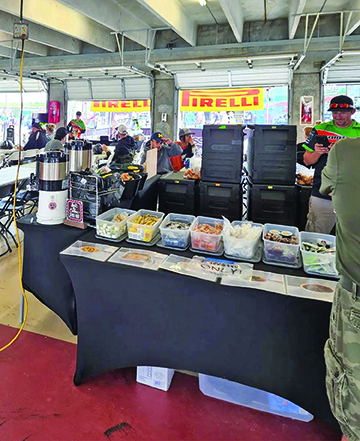
Feeding The Faith: Team Faith spreads the good word and feeds hungry riders at event competitions.
Understandably, Bannister likes high-energy music, and orchestrates his pre-race ritual accordingly. “I’m a really big punk rock guy,” he explains. “I also like pop-punk, so I usually go for a lot of Blink 182.”
As a member of Team Faith, Bannister also participates in the weekly ministry-based practice of feeding anyone and everyone in the race paddock (race team staging area) who might need a meal. With all of the privateer racers on a budget, it can amount to quite a few people.
“My favorite thing we cook that I like is the chicken because it’s healthy,” he laughs, “I go with that and a salad. I keep it kind of light because I have to race. I don’t care who you are, you’re always going to be nervous to a certain extent, so I try to keep the food down.”
Hometown Hero
A hometown hero, Bannister is quick to describe his love for his home state, “Colorado has its own feel. Nothing is like home,” he says.
“This sport requires huge jumps,” he notes. When Bannister is soaring above the track, for just a moment, he says, “A lot is happening really quickly … you just pinpoint a line and you do it in, literally, like, half a second.”
He sticks the landing and rides on.

by Charles Bonniwell | May 20, 2022 | Editorials

June 28 is fast approaching which is primary day for both Democrats and Republicans. For Democrats it is no big deal. A few races with more progressives versus less progressives’ candidates, but very little controversy or heartburn. For the Republican Party it is the seismic clash between two wings of the party that has been going on for decades, and may spell the end of the Republican Party as a viable political force in the state, assuming it still is one.
Across the country, the establishment of the Republican Party personified by Senate Minority Leader Mitch McConnell and former President George W. Bush, are battling in primaries with former President Donald Trump advocates who believe the 2020 election was stolen. While today’s battle in Republican circles in Colorado has some of the same battle lines, the war is far deeper. The Colorado Republican Party has been controlled for over 50 years, if not longer, behind the scenes by businessmen like billionaire Phil Anschutz. They have always looked down their noses at the grassroots of the party who do almost all of the volunteer hard work for the party but have little money. They view them as crude and unsophisticated but then need them to till the fields like serfs in imperial Russia. To keep them in line, the Colorado Republican establishment uses a small army of consultants to whom no amount of viciousness and corruption is too much. They are always the overseers of the Colorado Republican plantation with bull whips in hand.
Pursuant to the Republican Bylaws, as re-written by the establishment, the party chair is almost all powerful over the state party organization and thus the establishment feels it must control that position. The grassroots have successfully elected the party chair in 2015 with Steve House and 2021 with Kristi Burton Brown over establishment candidates only to find the establishment was able to turn their candidates against them. In 2017 the grassroots appeared to be on the cusp of electing State Representative Susan Beckman as chair so the establishment, in a panic, went to Washington and rushed in Republican Congressman Ken Buck to be party chair. The fight for party chair was a truly dirty one by the establishment in which the grassroots believed the overseers consultants corrupted the proxy voting process and then destroyed dirty work evidence right after the election.
The Republican Party has a hybrid nomination process. You can get on the ballot if 30% or more of the delegates to the applicable assembly vote for you. Alternatively, you can pay a signature gatherer firm to get enough Republican signatures vis a vis a petition to get on the nomination ballot. It’s costly but establishment candidates far prefer it rather than having to talk and convince lowly delegates for their votes. In their view it is so much more civilized.
 In this primary season, grassroots candidates won overwhelmingly in the respective congressional and state assemblies, with establishment candidates by and large gaining access to the ballot by petition. Because of a statewide referendum supported by establishment Republicans, unaffiliated voters get both a Republican and a Democrat ballot and can vote either one but not both, and the unaffiliated voters by numbers dwarf the number of Republican voters. Establishment candidates who have all the money hope by a dent of advertising dollars to overwhelm the grassroots with non-Republican voters to win the Republican nominations. If they don’t win a contest, they will refuse to contribute to any grassroots candidates in the general election and when they lose claim they were unelectable anyway in a general election.
In this primary season, grassroots candidates won overwhelmingly in the respective congressional and state assemblies, with establishment candidates by and large gaining access to the ballot by petition. Because of a statewide referendum supported by establishment Republicans, unaffiliated voters get both a Republican and a Democrat ballot and can vote either one but not both, and the unaffiliated voters by numbers dwarf the number of Republican voters. Establishment candidates who have all the money hope by a dent of advertising dollars to overwhelm the grassroots with non-Republican voters to win the Republican nominations. If they don’t win a contest, they will refuse to contribute to any grassroots candidates in the general election and when they lose claim they were unelectable anyway in a general election.
The grassroots have indicated they have had enough and if establishment candidates win the positions, they will not do any of the grunt work to get them elected, thereby also dooming their chances in a general election. Phil Anschutz and the establishment are willing to call what they see as a bluff by the grassroots. Thus, even though with President Joe Biden having an approval rating in the 30s in Colorado, and the Republicans having their best chance in a long time, it may not make a difference. Set forth below are the key races in the Republican primary on June 28 with the leading grassroots candidates listed first in italics and the leading establishment ones in regular font so you can see on election night who prevails if you so desire.
Governor: Greg Lopez – Heidi Ganahl
U.S. Senator: Ron Hanks – Joe O’Dae
Secretary of State: Tina Peters – Pam Anderson
U.S. Rep (C.D. 3): Lauren Boebert – Don Coram
U.S. Rep (C.D. 5): Dave Williams – Doug Lamborn
U.S. Rep (C.D. 7): Laurel Imer – Erik Aadland
U.S. Rep (C.D. 8): Lori Saine – Barb Kirkmeyer
U.S. Rep (C.D. 5): Bob Lewis – Ken Buck
— Editorial Board

by Glendale Sports Center | May 20, 2022 | Glendale City News
by Corinne Joy Brown, Aquatics Instructor, YMCA Metropolitan Denver
 As an aquatics instructor at the YMCA of Metropolitan Denver, I can attest that no two classes are alike — which is partly what makes the aquatics curriculum so popular.
As an aquatics instructor at the YMCA of Metropolitan Denver, I can attest that no two classes are alike — which is partly what makes the aquatics curriculum so popular.
Ironically, I avoided the water most of my life — believing that swimming laps was boring. I can attest that, after five years of attending aquatics classes and now teaching, nothing is more fun than aquatics! Finding myself in love with water exercise at 70 is the blessing of my mature adult life.
For over 20 years I have made my living as a writer, and I recently began to see similarities between writing and teaching aquatics. Below are some lessons that transcend from writing to teaching:
Lesson One: Come As You Are
An author shows up as transparent as possible, bringing every experience we’ve ever had to that first blank page. I feel the same way when I stand in front of aquatics students. In our class, there’s no judgment. Each attendee is the sum of their own experiences, as is the instructor, all coming together in that great equalizer: the water. As in writing literature, the more I am myself in class, the more I seem to connect. Over time, I have begun to learn more about each student and their own stories as well; characters in a one-hour, life-changing aquatic challenge.
Lesson Two: Be Observant
A good writer notices things, picks up on details, and keeps a running file on the environment including facial expressions and atmosphere. A good aquatics teacher notices those things too, assessing by-the-minute if the participants are engaged, confused or distracted, and then acts on them.
Lesson Three: Structure
A good book has a beginning, middle, and end. So does a good aquatics class, from the cardio-enhancing warm-up through the cool down. It also depends on a consistent sense of structure, allowing enough time for each phase. Like a good story, you want to keep your audience wanting more and throw in some surprises. And like any satisfying ending, reaching a sense of joy by the end of every class.
Lesson Four:
Start With An Introduction
I make a point to introduce new people to the class and welcome them. Like a preface to a book, I use the beginning of class to set the stage for the day’s direction. These moments help create a sense of purpose, allow me to see who is in the water, and assess my workout strategy.
Lesson Five: Create A Sense Of
Community And Connection
A good writer and aquatics instructor targets their readers/swimmers and stays in touch in order to create a community. Students show up for more than just a workout. What’s good for the body is good for the soul, and each one of our YMCA aquatics classes offers a safe environment and a chance to be in the moment, feel connected, move, and experience a sense of release — not to mention the camaraderie that naturally ensues.
The Y plays a vital role in the community, serving as a safe, welcoming, and inclusive third place, a place beyond work and home.
I recently asked my class what they loved most about aquatics. The most recurring answer was “It just feels so good.” That sentence contains it all. In our classes, personal growth is evident and measurable in terms of increased strength and flexibility, as well as visible confidence and a sense of well-being. The YMCA Metropolitan Denver offers private, semi-private, and group swim lessons for individuals of all ages. Visit www.denverymca.org for more information.

by Regan Bervar | Apr 21, 2022 | General Featured
“No one is immune from addiction; it afflicts people of all ages, races, classes, and professions.”
 by Luke Schmaltz
by Luke Schmaltz
The fundamental allure of using drugs is state change. The human nervous system is a pleasure-seeking construct. In the relentless pursuit of gratification, the human brain has developed an ability to manufacture state-changing compounds such as dopamine and oxytocin.
Modern ingenuity is locked in an undying quest to replace all physical and mental exertion with painless luxury. In doing so, it has removed all effort from dealing with pain and mental unrest and created a smorgasbord of delights for every proclivity, every unique brain chemistry, and every personality.
According to the National Institute for Children’s Health Quality (nichq.org), “Over 20,000 babies are born each year dependent on illegal or prescription drugs” having inherited their mother’s addictions while in the womb. Regardless, every person in the developed world, at an early age, will be bombarded by the concept of ingesting substances that are designed to fix problems and change the way they feel. Through television, internet, streaming video, audio programming, pop culture, peer pressure, and parental behavior — most people come to understand the concept of getting “messed up” at an early age.
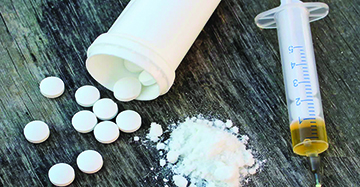
The pervasive inclusion of fentanyl in illegal street drugs and imitation prescription pills is increasing overdose deaths exponentially.
Those among the populace unfortunate enough to be born with certain types of brain chemistry, an addictive personality, or a wide variety of mental issues can become hooked on any number of toxic substances. These can include alcohol, tobacco, methamphetamine, heroin (opioids), cocaine, methadone, and more. Much more.
The specter of addiction hangs over Western society as a constant reminder of how capitalism is hardwired to accommodate the penchant for instant gratification. A culture of escapism and sensory overload is perfectly suited to appease the human tendency to embrace denial and avoid dealing with problems head on.
Start Prevention At An Early Age
Just as children are taught to look both ways before crossing the street and to avoid interacting with strangers on said streets, the topic of addiction should be presented and prioritized with the same immediacy. Yet, Western society, in its infinite irony, is harming kids by keeping them in the dark in an effort to protect them from life’s harsh realities. In most instances, kids simply have no concept of how easy it is to get hooked and the possible outcomes — most of which can be anywhere from unfortunate to tragic.
Education on drugs and addiction starts at home, whether it is through candid conversations between parents and kids or through parental neglect to broach the subject. The former takes the hearsay and mythos out of the equation and creates healthy dialogue between parents and kids. The latter leaves curious children to seek answers elsewhere through their peers, social media, or by observing parental behavior — all of which can be misleading. According to a 2021 report published by SAMHSA (Substance Abuse and Mental Health Services Administration), “If you talk to your kids directly and honestly, they are more likely to respect your rules and advice about alcohol and drug use. When parents talk with their children early and often about alcohol and other drugs, they can protect their children from many of the high-risk behaviors associated with using these drugs.”

The American Heart Association provides sobering insight into the harmful effects of nicotine.
The same report explains that by the age of 15, 50% of kids will have tried alcohol and the same number will have tried an illegal drug by the time they are seniors in high school. State-changing substances are pervasive and inescapable, so the ideal way to deal with them is to take the guesswork away from inquisitive children and explain, in clear language, that drugs can easily harm them, poison them, and kill them.
Escape The Vape
Nicotine is highly addictive and is now available in seemingly harmless vapor form — packaged in flavors such as bubble gum, sweet tarts, gummy bears, and chocolate — which are highly appealing to kids. Since combustion is not involved, vaping can seem like a consequence-free way of obtaining a nice buzz, but the reality of the situation is that, according to the CDC (Centers for Disease Control), “Nicotine can harm the developing adolescent brain and the parts of the brain that control attention, learning, mood, and impulse control.”
Understand The Impulses

Peer pressure can be a big contributor to what causes kids to use drugs.
A child is compelled to use nicotine for the same reasons an adult reaches for a pack of cigarettes, temporary relief from depression and anxiety. You can prevent your kids from getting hooked on nicotine (which can lead to harder drugs) by pinpointing circumstances which are causing stress in the child’s life. Confronting these issues head on and exploring healthy ways to cope such as therapy, exercise, and communication can prevent a child from developing an addictive personality, and it can also strengthen the relationship between children and their parents. Mitigating the fallout from exposure to nicotine and habitual use, according to the American Heart Association, is to establish a comprehensive nicotine-free philosophy which includes vaping, chewing tobacco, and cigarettes. If kids are smoking, it is important to start a dialogue and find out why. The AHA says, “Instead of punishment, offer understanding and help to resist the dangerous lure of tobacco use and addiction.”
Take A Hardline Approach
The defelonization of many hard drugs such as crack cocaine, methamphetamine, and the deadliest of all — fentanyl — is further increasing their availability. If a kid wants to try any one of them, the fact is they don’t have to try very hard to get their hands on some dope. Currently, the establishment’s passe’ attitude toward drug use is sending a message to kids that it’s really no big deal to get high all the time. By accommodating drug addicts with so-called “harm reduction” policies, they are making it an everyday affair for otherwise healthy kids to take drugs, get hooked and possibly overdose and die. Just as adults tell their kids not to drink bleach (poison) and swan dive off 100-foot-high cliffs, adults who want to keep their kids away from addiction should consider talking to their kids often and at great length about the clear and present danger of getting high. This is especially cru
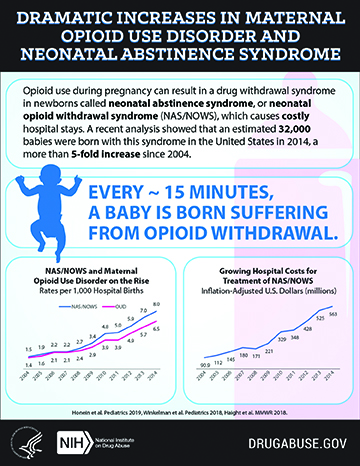
Babies born dependent on drugs suffer from NAS (Neonatal Abstinence Syndrome), a type of opiate withdrawal.
cial with the advent of Fentanyl — a compound which, according to Colorado.edu, is “50 to 100 times more potent than heroin or morphine.”
Kill The Pills
Additionally, the undying popularity of over-the-counter drugs has created a market for counterfeit pills — most of which contain fentanyl. While the pharmaceutical industry is finally being regulated after getting millions of people hooked on their products and claiming untold amounts of human life, the monster they created has taken on a life of its own. The demand for pills that make you feel better has become part of the permaculture, and if people can’t get them legally, they will simply find another way.
The Western medicine approach to mental illness takes the path of least resistance; misdiagnose, overprescribe, and move on to the next patient. The idea of delving into an afflicted person’s unique circumstances and getting to the root of their problems has been deemed by many, both subjects and practitioners, as too time-consuming and simply too damn hard. Thus, the motto, “Take two and call me in the morning.” The idea that feeling better and getting away from your troubles is as easy as unscrewing the lid to a child-proof bottle is flat-out false and should be stricken from the narrative.
Kids should be told, in no uncertain terms, that life can and will be hard sometimes, and staying clean takes constant awareness and vigilance. Pursuing chemically-induced state-change can really screw a person up, can lead to an untimely death and a life-changing tragedy for a family. Tell them the truth, they can handle it.
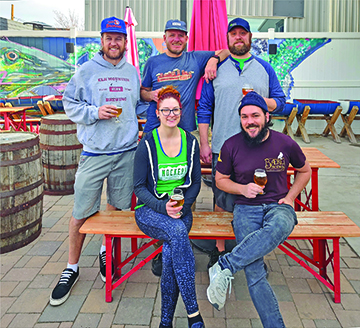
by Mark Smiley | Apr 21, 2022 | Travel
by Mark Smiley

Collaboration Fest: The Fillmore Auditorium was the venue for the 7th Collaboration Fest on April 2, 2022.
After a two-year hiatus, Collaboration Fest returned on April 2, 2022, at the Fillmore Auditorium. Ticket holders who purchased tickets to the 2020 fest that was cancelled due to the pandemic enjoyed over 150 beers. Guild members teamed up with fellow local and national brewers to create unique and interesting beers that were brewed specifically for this event.
Dubbed as one of the most unique and creative beer festivals in the world, Collaboration Fest is an annual beer festival hosted by the Colorado Brewers Guild. The Colorado Brewers Guild is a non-profit trade association representing Colorado craft breweries and brewpubs founded in 1995. CBG sponsors various beer events each year, such as the Colorado Pint Day, Colorado Brewers Rendezvous, Colorado Strong, and the Collaboration Fest. All of these are designed to increase awareness and appreciation of Colorado brewed beer.
“The sheer number of collaboration beers tapped in one single day is phenomenal,” said Shawnee Adelson, CBG executive director before the festival. “Beer lovers will get to sample everything from tried-and-true styles to some off-the-wall creations. There will be something for everyone at Collaboration Fest.”
Mockery Brewing and Baere Brewing Company collaborated for the seventh time spanning the entire life of the festival. Their first collaboration was Mocking Baered Episode I: Lost On Lacto Island. It started as a joke but then became a story they have told over the course of seven years collaborating together.
“This year, it is an Imperial Red [MockingBaered Episode 7: Some like it Hot!] with a lot of spicy and hot peppers, carrots, ginger, and smoked pineapple,” said Zach Rabun, owner of Mockery Brewing. “We are dipping back into some old recipes for this one. Chile beers are already a pretty polarizing category so we definitely want people to know that they’re going to have a chile beer,” said Ryan Skeels, owner of Baere Brewing Company. “This year we decided to incorporate some elements from collaborations of years past and throw a scorching amount of heat into an otherwise malty, sweet, and fruity beer.”

Mockery & Baere: Back row, left to right: Zach Rabun, owner of Mockery Brewing; Ryan Skeels, owner of Baere Brewing Company; and Jason Woody, Head Brewer of Mockery Brewing. Front row, left to right: Mandie Hardison, Mockery Brewing; and Matt Schenck, Head Brewer of Baere Brewing Company.
Collaboration Fest is among the beer fests that attendees look forward to the most. Also, brewers enjoy this one and were excited to see it return. “I think it would be a universal, industry response that there would be nothing but good things said about it [Collaboration Fest],” said Rabun. “We all do a bunch of different festivals in different formats all throughout the year but collab fest stands out because of the format and while we see the same handful of people at all festivals, this one is unique because everyone is pouring something that was created purposely for this festival. So, it’s not their normal lineup of beers you see at every other festival. You can see the different identities of each brewery and it’s cool to see what they can come up with.”
“Mockery is known for putting unique ingredients in their beers in a thoughtful way and now this is the one time a year that everyone decides they should do that so it is pretty fun,” said Skeels.” “Collab beers tend to be more experimental.”
Other stand outs at the festival were Comrade Brewing Company and Cheluna Brewing Company who collaborated on Szech Juan IPA, an American IPA with Szechuan chiles/peppercorns and Tamarind pulp for a combination of sweet/ spicy/hoppy to hit all the bases. “It’s great to have the festival back after a 2-year hiatus,” said David Li, owner of Comrade Brewing. “It showcases the community and camaraderie the craft brewing industry has. The szechuan peppercorn tamarind IPA we brewed with Cheluna Brewing finally happened after we were talking about it in early 2020.”
Comrade Brewing also teamed up with Glenwood Canyon Brewing Company to brew an American Style Double IPA. They experimented with Thiol enhanced brewing techniques for this collab. Jake Lancaster (Glenwood Canyon), Mark Lanham and David Lin (Comrade) have known each other for some time, and each got the ball rolling on this project.
All collaboration beers can be found at each brewery while supplies last. Comrade Brewing is located at 7667 E. Iliff Ave. in Denver, Mockery Brewing is located at 3501 Delgany Street in Denver, and Baere Brew-ing Company is at 320 Broadway in Denver. For a complete list of beers, visit collaborationbeerfest.com. Follow the Colorado Brewers Guild on social media @coloradobrewers guild.


















